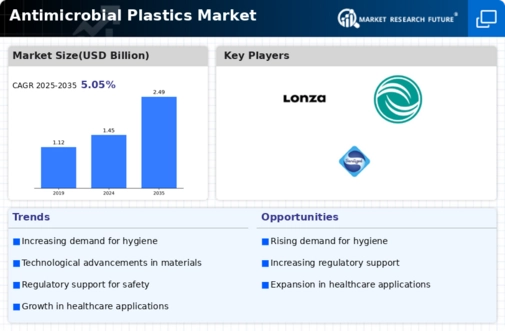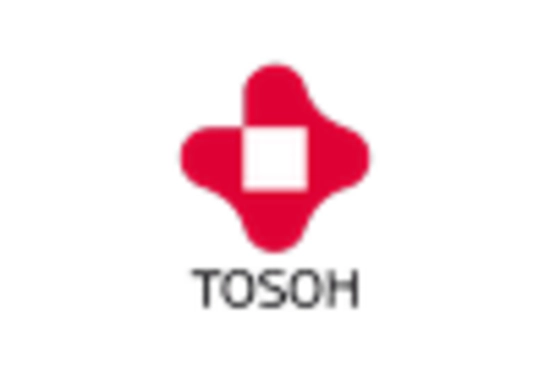Increased Regulatory Support
The Antimicrobial Plastics Market benefits from a growing framework of regulatory support aimed at promoting the use of safer materials. Governments and health organizations are increasingly advocating for the adoption of antimicrobial plastics in various applications, particularly in healthcare and food packaging. This regulatory push is often accompanied by guidelines that encourage the use of materials that can reduce the spread of infections and enhance public health. For instance, certain regions have implemented standards that require the use of antimicrobial materials in medical devices and hospital environments. This regulatory environment not only fosters innovation but also provides manufacturers with a clearer pathway to market entry, thereby stimulating growth in the antimicrobial plastics sector. As a result, companies are likely to invest more in research and development to comply with these regulations, further driving the market forward.
Rising Demand in Consumer Goods
The Antimicrobial Plastics Market is experiencing a notable surge in demand within the consumer goods sector. This trend is largely driven by heightened consumer awareness regarding hygiene and safety. Products such as kitchenware, toys, and personal care items increasingly incorporate antimicrobial plastics to mitigate the risk of bacterial contamination. Market data indicates that the consumer goods segment is projected to account for a substantial share of the overall market, with an estimated growth rate of approximately 8% annually. This growth reflects a broader societal shift towards prioritizing health and wellness, thereby propelling manufacturers to adopt antimicrobial solutions in their product lines. As consumers seek assurance in the safety of everyday items, the integration of antimicrobial properties in plastics becomes a strategic imperative for companies aiming to enhance their market competitiveness.
Rising Awareness of Infection Control
The Antimicrobial Plastics Market is experiencing growth driven by an increasing awareness of infection control measures across various sectors. This heightened awareness is particularly evident in healthcare settings, where the need for materials that can effectively reduce the transmission of pathogens is paramount. Hospitals and clinics are increasingly adopting antimicrobial plastics in medical devices, equipment, and surfaces to enhance infection prevention strategies. Market data suggests that the healthcare segment is projected to witness a growth rate of approximately 7% annually, reflecting the critical importance of maintaining sterile environments. Additionally, this trend is extending to other sectors, such as food service and public transportation, where the demand for antimicrobial solutions is rising. As organizations prioritize health and safety, the adoption of antimicrobial plastics is likely to become a standard practice, further propelling the market forward.
Growing Applications in the Automotive Sector
The Antimicrobial Plastics Market is witnessing an expansion in applications within the automotive sector. As vehicle manufacturers increasingly prioritize passenger safety and comfort, the integration of antimicrobial plastics in interior components is becoming more prevalent. These materials are utilized in areas such as seat covers, dashboards, and door panels to inhibit microbial growth, thereby enhancing the overall hygiene of vehicles. Market analysis suggests that the automotive segment is expected to grow at a compound annual growth rate of around 6% over the next few years. This growth is indicative of a broader trend where automotive companies are seeking innovative solutions to differentiate their products in a competitive market. By incorporating antimicrobial properties, manufacturers not only address consumer concerns regarding cleanliness but also enhance the longevity and durability of automotive interiors.
Technological Innovations in Material Science
The Antimicrobial Plastics Market is significantly influenced by advancements in material science and technology. Innovations such as the development of new antimicrobial agents and the enhancement of polymer formulations are enabling manufacturers to create more effective and durable antimicrobial plastics. These technological breakthroughs are crucial in meeting the diverse needs of various industries, including healthcare, food packaging, and consumer goods. For instance, the introduction of nanotechnology in antimicrobial plastics has shown promising results in improving efficacy against a broader spectrum of pathogens. Furthermore, the ability to tailor the properties of these materials allows for greater customization, which is increasingly demanded by end-users. As research continues to evolve, the market is likely to see a proliferation of novel antimicrobial solutions that cater to specific applications, thereby driving growth and expanding the scope of the industry.


















Leave a Comment